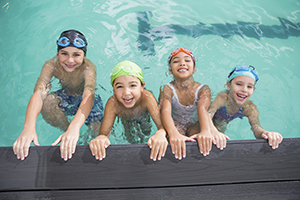Swimming Safety for Children with ADHD

Summer is here, and the swimming pool is crowded!
Swimming has health benefits in addition to being an enjoyable and social activity for children. Keeping kids safe without ruining the fun is a serious concern for parents, especially when their children have ADHD. The risks of water accidents and drowning increases during the summer as families open backyard swimming pools, vacation at hotels and resorts where there is a pool, or go to the local community pool. Children with ADHD can be at a greater risk of accidents due to impulsivity and inattention.
You can do several things to help your child have a safer swimming experience, beginning with understanding your child’s needs related to his ADHD diagnosis, along with establishing clear rules for safe behavior.
Water Safety:
- Enroll your child in swimming lessons that are certified by a national agency, such as the American Red Cross. For the youngest children, look into baby and toddler safety classes that you and your child can take together.
- New swimmers should have appropriate water flotation devices they can wear in the pool, such as “swimmies” for their arms, “bubbles” worn on their back, or life-vests and life-shirts that are designed to keep a child’s face above water. Make sure the flotation device is approved by the United States Coast Guard (look for the label) before using. Even with these devices on your child, never leave a new or young swimmer unsupervised in and near the water.
- Keep non-swimmers and those not comfortable swimming in the shallow end of the pool.
- Limit the number of water toys in the pool or keep them out entirely if there are a lot of people swimming. Water toys can trap children and make it hard to see when a swimmer is struggling.
- Make sure your public swimming pool has a certified lifeguard on duty. For private, hotel, and home swimming pools, actively supervise your children while in or near the swimming pool. Many children overestimate their swimming abilities, so keep a constant eye on your child until you are comfortable with his skills.
- Make a rule that children do not swim without an adult present.
Healthy Swimming:
- Children should have on water-resistant sunscreen, with at least SPF 15 that blocks both UVA and UVB rays, or wear specially designed swim shirts to prevent sunburn. Out of the swimming pool, sun hats can help protect their faces and eyes.
- Teach children not to swallow pool water.
- Children with diarrhea, opens sores, or who are feeling sick should not go swimming until they are better.
- Make a firm rule that children must get out of the water to use the restroom. Take children for restroom breaks on a regular basis. Check swim diapers frequently and change diapers in a changing area, not at poolside.
Be proactive:
- Role-play the rules and swim activities. Children affected by ADHD often need practice to know what is expected before going to the pool.
- For home swimming pools, make sure you have appropriate fencing around the pool.
- Be mindful of your child’s tendency for impulsivity or inattention. Children might need frequent reminders of the rules while at the pool or may need scheduled breaks from the activity.
- If your child has been prescribed a medication for his ADHD, be sure he has taken his medication before going to the swimming pool.
- Learn to recognize a person in distress in the water. A person who is drowning does not look like how it appears in the movies. They do not wave their hands around and yell. This video shows how to recognize drowning.
- Take a water safety class that includes CPR. Being prepared for an emergency can make the difference if there is a problem in the water.
For more information, visit CDC’s Safe Swimming Pool Guidelines.
